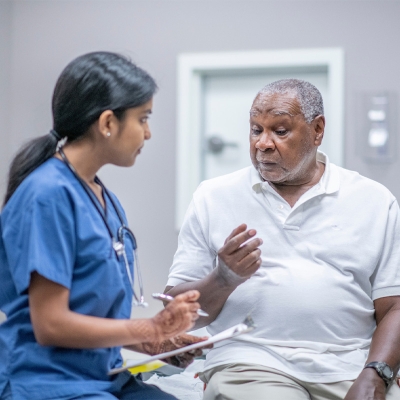

Expert Support for Life’s Unexpected Turns
Being put on life support or having a loved one undergo lifesaving measures can be overwhelming and difficult, especially when there are processes or devices you may not understand. We want you to know that we’re here for every step and to answer every question.
Our AdventHealth Heart, Lung and Vascular Institute medical teams are dedicated to whole-person health care for you and your family. Count on us to look after you in body, mind and spirit.
What to Expect With ECMO Support
With ECMO, there’s a lot to know. We want you to feel informed, and we’ll make sure you’re supported in more ways than one.
Clotting is the body’s natural reaction to anything that’s not supposed to be there, like the tubes of the ECMO machine. Some patients may require anticoagulation (blood thinning) medication to prevent blood clots. ECMO patients on these drugs are at risk of bleeding and may need blood transfusions. This is a common, expected occurrence.
Because patients on ECMO are extremely sick, many require constant IV medications to regulate their blood pressure, help their heart beat regularly or prevent infection.
Some ECMO patients may need other support devices, such as a ventilator (breathing machine) support and may be sedated to help them rest and recover.
Many V-V-ECMO patients who need lung support may also develop mucus in their lungs, requiring frequent suctioning by a nurse or respiratory therapist. Some patients may require bronchoscopies, where a small tube with a light and suction port allows the critical care provider to see and clean out the lungs.
Some ECMO patients may need breathing machine support for prolonged periods. This means the breathing tube in their mouth may need to be removed and replaced with a shorter tube, known as a trach, in their windpipe or trachea. This tube is more comfortable for the patient and could allow the team to decrease sedation and begin to wake them up.
Some patients with lung infections may need to be placed in a prone position — on their belly — for better oxygenation.
ECMO patients will continue to need nutrition, so if they cannot eat independently, they may have a feeding tube placed in their mouth, nose or stomach to allow for feeding. Sometimes, they may receive nutrition through their IV if stomach feeding is not an option. Nutrition is vital to recovery, and feeding is discussed daily.
You or your loved one will be watched closely by our devoted ICU team. This monitoring will include constant vital sign monitoring, X-rays, labs, echocardiograph (EKG or ECG), echocardiogram (ECHO) and potentially other diagnostic testing.
There may be multiple devices in an ECMO patient’s room, depending on their needs. As an ECMO room can become crowded quickly, please ask your nurse, respiratory therapist or ECMO specialist what each device does so that you can become familiar with the type of support you or your loved one needs.
Aside from the ECMO machine, there may be a breathing machine or ventilator, a continuous renal replacement therapy (CRRT) device, IV pumps, chest tubes and drainage systems, suction tubing, a foley catheter in the bladder, rectal drainage tubes or feeding tubes.
ECMO patients can look swollen, especially in the first few days. This is because they may need extra fluid for the ECMO device to work, but their kidneys can’t keep up. We monitor kidney health closely, but in some cases, the patient may need to be placed on a CRRT device. This is a slow type of dialysis, removing fluid and filtering for the kidneys.
Some ECMO patients may develop heart failure in different areas of the heart and require extra support to help the heart recover. Some patients may have an Impella® or an intra-aortic balloon pump to support the heart and allow it to rest. Others may have a ventricular assist device (VAD) to help pump blood from the heart to the rest of the body.
Pain may be a factor in ECMO care and will be carefully treated with medication. Pain scales are used for patients who cannot speak, along with monitoring vital signs that suggest the patient may be in pain. For these patients, pain medication is given continuously through their IV, and the nurse regulates the dose according to the patient’s hourly assessments, pain scale and vital signs.
For ECMO patients on a ventilator, sedation is most often given to ensure they remain calm and comfortable. Like pain medication, sedation meds are given constantly through IV. Sedation is adjusted by the nurse according to the patient's sedation scale, vital signs and hourly assessments that may suggest if the patient is uncomfortable.
In some cases, ECMO patients may need extra pain and sedation medication for unexpected pain and discomfort. The nurses administer these medications as needed based on pain and sedation scales, hourly assessment findings and vital signs. These extra doses are only given if it is safe to do so.
Patients who cannot move are turned and positioned for their comfort every two hours as needed. This aids in comfort and pain prevention and also guards against skin issues.
Nurses may also use heat or cold packs for localized pain and discomfort. Your nurse will answer any questions you have about pain or comfort.
If an ECMO patient is stable while awake, walking and physical therapy will be part of their daily routine. This may include walking many times a day with the ECMO team or exercising throughout the day. Our physical or occupational therapist teaches these movements to the patient and family. They will help the patient get back to the routine of caring for themselves and rebuilding their strength.
Sometimes, rehab exercises will feel very difficult, but this is an important part of recovery. Patients who participate in their rehabilitation typically experience faster recovery and fewer complications.
To ensure a sedated ECMO patient’s brain is functioning properly, their sedation and pain medications must be regularly reduced — or even turned off — for a short time. This allows a nurse to perform a spontaneous awake trial (SAT), a neuro assessment.
This process may be uncomfortable for the patient and difficult for family members, but it is a crucial part of the process to ensure the patient can wake up. The SAT allows the team to identify any potential brain injury early enough for treatment. If the patient is not ready to come off the ventilator, they will be immediately placed back on their pain and sedation medications, which the nurse will adjust until the patient is comfortable.
If the ECMO patient appears ready to come off the ventilator or is calm and comfortable, their pain and sedation medication will remain at a low rate or may be stopped. In this case, the respiratory therapist will turn down the ventilator and assess for regular breathing. This spontaneous breathing trial (SBT) will inform the team if the patient can come off the ventilator. If not, the ventilator will be adjusted to as low a rate as the patient can tolerate. This is referred to as ventilator weaning.
The SAT and SBT tests allow our ECMO team to safely wean sedation, pain medication and ventilation. We know this process can be hard for families, but we are here to support you and your loved one. We will always ensure we are safely addressing their pain and discomfort.
Many ECMO patients require multiple diagnostic tests and procedures during their hospital stay.
Some procedures may include the addition of central venous lines for medication access, pulling and replacing these lines as needed, hemodialysis line placement and replacement, the addition of chest tubes and other drains and, in some cases, surgical procedures.
Blood testing and X-rays are often a daily occurrence. Computed tomography (CT) scans and interventional radiology are also common.

An Expert Team for Wholehearted Support
ECMO care requires a large team, each member an expert in their area. Rest assured, you or your loved one will receive the best care from our talented and compassionate clinicians. The ECMO team includes, but isn’t limited to, the following roles:
- Cardiac surgeon
- Chaplain
- Critical care physician
- ECMO clinical specialist
- ECMO registered nurse
- Registered respiratory therapist
Download Our ECMO Guide
Our PDF guide on ECMO care features more in-depth information about the ECMO machine, how to support a loved one on life support and a glossary of terms and acronyms you might encounter.

We're Here to Guide You at Every Step
Your Cardiac Concierge at the AdventHealth Heart, Lung and Vascular Institute is here to help you understand your treatment or a loved one’s. They’ll be your advocate and assistant through the journey, allowing you to focus on what matters most: healing.
Contact Us